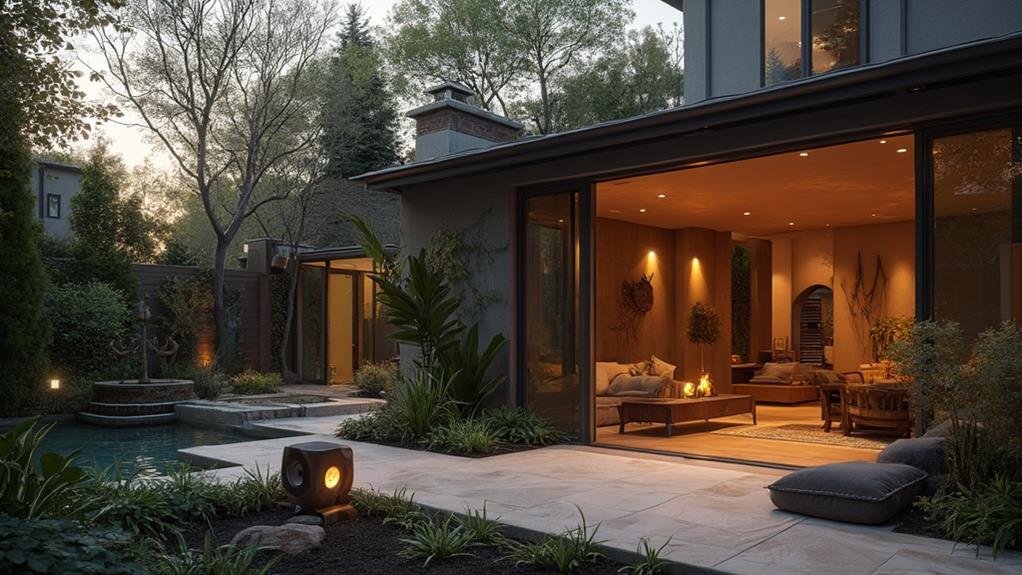Sound design for outdoor spaces blends acoustic principles with landscape design to create immersive auditory environments. Key considerations include understanding outdoor acoustics, incorporating natural sound elements, and strategically placing speakers for optimal coverage. Masking unwanted noise with water features and vegetation helps maintain a pleasant atmosphere. Seasonal changes and weather patterns affect sound propagation, requiring flexible systems to adapt. Integrating audio equipment seamlessly with landscaping ensures a cohesive aesthetic. Smart technology can enhance the outdoor audio experience, allowing for customized zones and remote control. By carefully harmonizing sound design with landscape elements, homeowners can create seamless indoor-outdoor transitions that expand their living space.
Understanding Outdoor Acoustics
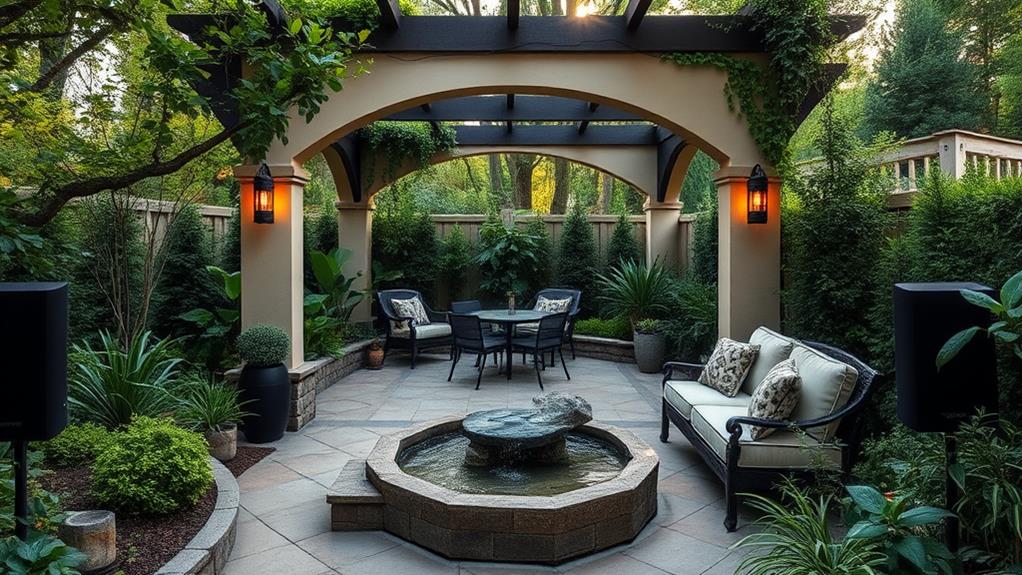
When designing sound for outdoor spaces, understanding the unique acoustics of open-air environments is crucial. Unlike enclosed indoor spaces, outdoor areas lack walls and ceilings to contain and reflect sound waves, resulting in different acoustic properties. Sound dissipates more quickly outdoors, affected by factors such as wind, temperature, humidity, and surrounding structures.
Outdoor acoustics are characterized by reduced reverberation and increased background noise. Natural elements like trees, grass, and water bodies can absorb or reflect sound, altering its propagation. Hard surfaces like concrete or stone may create echoes or amplify certain frequencies. The absence of enclosures means that sound travels farther, potentially causing noise pollution in neighboring areas.
To effectively design sound for outdoor spaces, consider the following:
- Sound source placement and directionality
- Environmental factors and their impact on sound propagation
- Ambient noise levels and masking effects
- Acoustic barriers and absorptive materials
- Time of day and seasonal variations in sound transmission
Natural Sound Elements
In the realm of outdoor sound design, natural sound elements play a crucial role in creating immersive and harmonious environments. These elements include water features, wind chimes, rustling leaves, and wildlife sounds, all of which contribute to a rich auditory landscape.
Water features, such as fountains, streams, or waterfalls, provide a soothing backdrop that can mask unwanted noise and create a sense of tranquility. The gentle tinkling of wind chimes adds a melodic element that responds to air currents, creating a dynamic soundscape.
Incorporating native plants and trees not only enhances visual appeal but also introduces natural rustling sounds as breezes pass through leaves and branches. Additionally, designing spaces that attract local birds and insects can introduce chirping, buzzing, and other wildlife sounds, further enriching the auditory experience.
When carefully curated, these natural sound elements work in concert to create a multisensory outdoor environment that feels both invigorating and relaxing. By leveraging these organic sound sources, designers can craft outdoor spaces that seamlessly blend with their surroundings and provide a welcome respite from the cacophony of urban life.
Strategic Speaker Placement
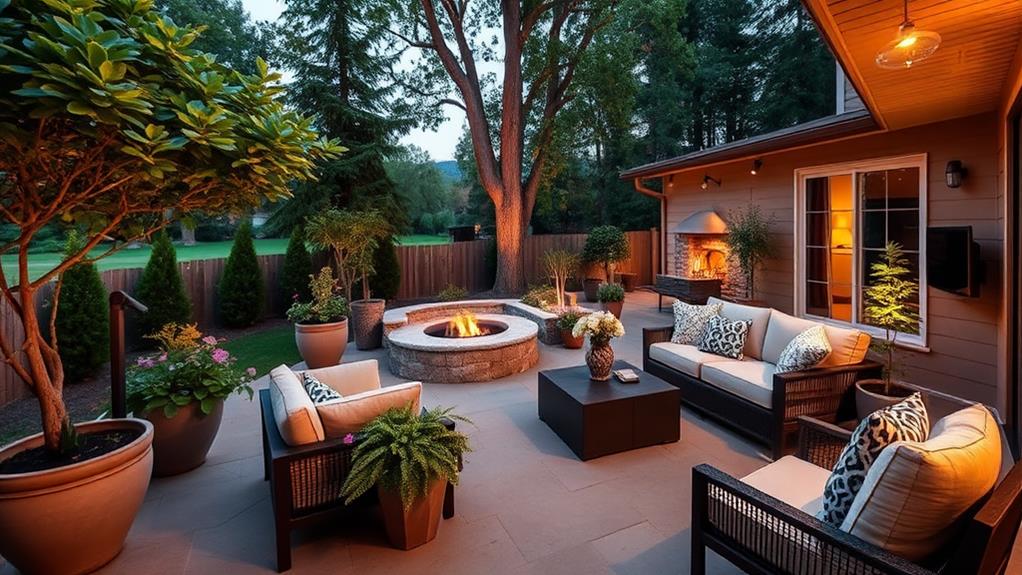
Strategic speaker placement sets the stage for an immersive outdoor audio experience. When designing an outdoor sound system, consider the layout of the space and the desired audio coverage. Begin by identifying primary listening areas, such as seating zones or gathering spots.
Position speakers to direct sound towards these focal points while minimizing noise pollution to neighboring properties. Employ a distributed speaker system to ensure even coverage across larger areas. Mount speakers at ear level or slightly above for optimal sound projection.
Weather-resistant, camouflaged speakers can be integrated into landscaping elements like rocks or planters for a seamless aesthetic. For expansive spaces, consider using satellite speakers in conjunction with a central subwoofer to maintain audio quality and bass response.
Pay attention to potential obstacles that may interfere with sound transmission, such as walls, trees, or architectural features. Use these elements strategically to reflect or absorb sound as needed. Implement zoning capabilities to allow for independent volume control in different areas, accommodating various activities or preferences.
Masking Unwanted Noise
While strategic speaker placement optimizes sound distribution, addressing unwanted noise is equally important in outdoor audio design. Masking unwanted noise involves creating a pleasant sonic environment that minimizes intrusive sounds from neighboring properties, traffic, or other sources.
One effective technique is to incorporate water features, such as fountains or waterfalls, which produce consistent, soothing white noise. This natural sound can help obscure less desirable noises and create a more tranquil atmosphere. Similarly, wind chimes or rustling ornamental grasses can add subtle, pleasant tones to the outdoor space.
Another approach is to use directional speakers aimed away from noise sources, focusing sound in specific areas where people gather. Additionally, installing acoustic barriers like fences, walls, or dense vegetation can help absorb and deflect unwanted noise.
For more precise control, consider implementing a sound masking system. These systems emit low-level background noise specifically designed to cover up intrusive sounds without being noticeable themselves. By carefully balancing the masking noise with the desired audio, outdoor spaces can achieve a harmonious auditory environment that enhances the overall experience.
Water Features for Ambiance
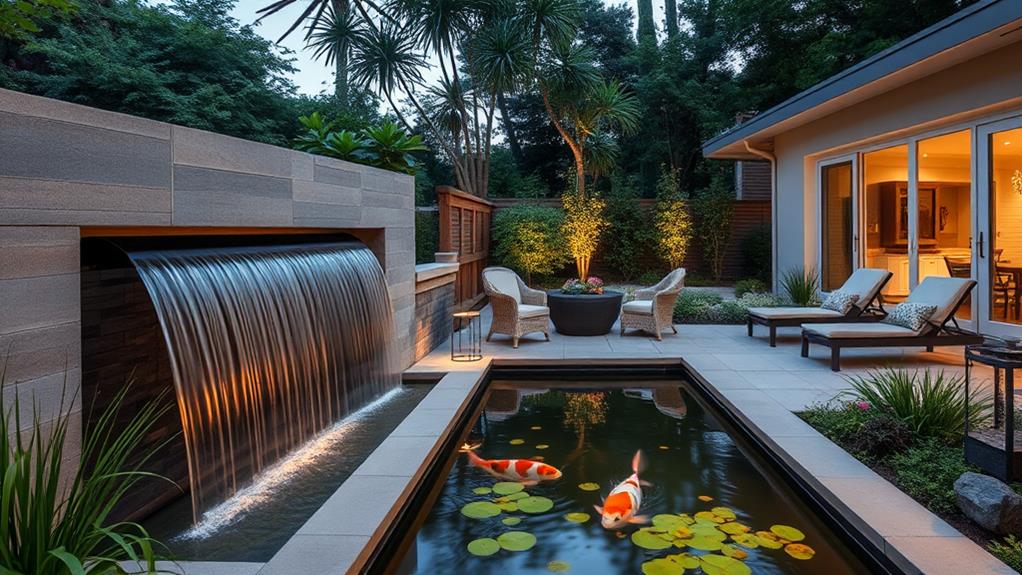
The gentle trickle of water can transform an outdoor space into a serene oasis. Water features not only provide visual interest but also contribute significantly to the auditory landscape of outdoor environments. From cascading fountains to bubbling streams, these elements create a soothing background sound that masks unwanted noise and enhances relaxation.
When designing water features for ambiance, consider the scale and style of your outdoor space. Small, tabletop fountains work well in intimate settings, while larger installations like waterfalls or ponds can anchor expansive areas. The sound produced by water features can be customized by adjusting the flow rate, height of water drop, and surface materials. Smooth stones create a gentler sound, while textured surfaces generate more lively acoustics.
Strategically placing water features near seating areas maximizes their auditory impact. Additionally, incorporating lighting can extend the sensory experience into evening hours. When selecting pumps and filtration systems, opt for quiet models to ensure the water sounds remain the focal point. Regular maintenance is essential to preserve water quality and optimal sound performance.
Integrating Smart Audio Technology
Modern outdoor spaces are evolving beyond traditional sound elements to incorporate smart audio technology. These advanced systems offer homeowners unprecedented control over their outdoor audio environment, allowing for seamless integration with existing home automation setups.
Weatherproof speakers with Wi-Fi and Bluetooth connectivity can be strategically placed throughout the landscape, providing high-quality sound that can be controlled via smartphone apps or voice assistants. Multi-zone audio systems enable different areas of the outdoor space to play separate audio streams simultaneously, catering to diverse preferences during gatherings.
Some smart outdoor audio systems feature adaptive sound technology, which adjusts volume and equalization based on ambient noise levels and weather conditions. This ensures optimal audio quality regardless of environmental factors. Additionally, motion sensors can be incorporated to trigger audio playback when someone enters a specific area, creating an immersive experience.
Energy-efficient LED lighting can be synchronized with the audio system, creating a cohesive audiovisual atmosphere for entertaining or relaxation. Many smart outdoor audio solutions also offer scheduling capabilities, allowing homeowners to automate sound experiences throughout the day or week, enhancing the overall outdoor living experience.
Seasonal Sound Considerations
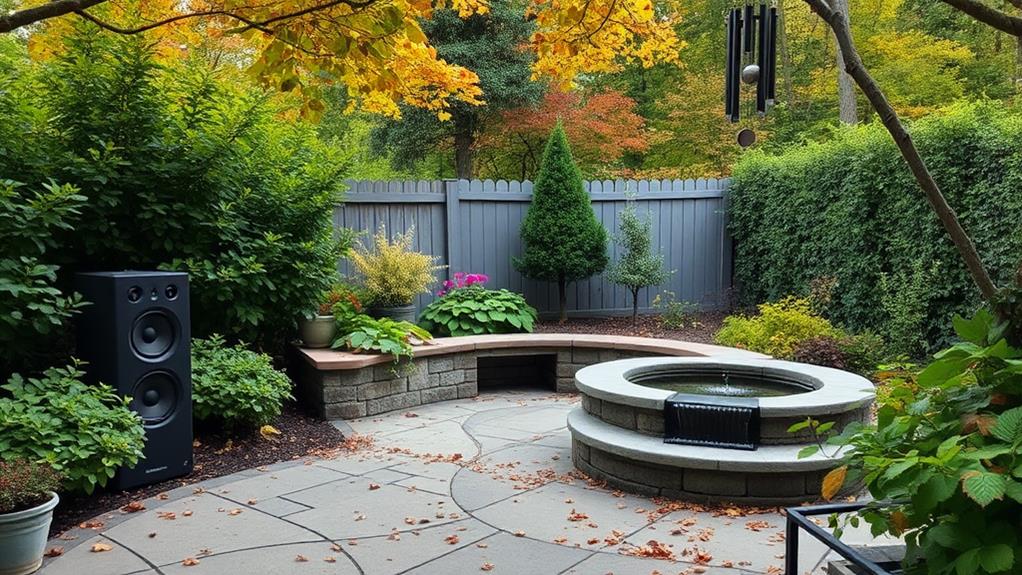
Adaptability is key when designing sound for outdoor spaces, as seasonal changes can significantly impact the acoustic environment. Different seasons bring unique challenges and opportunities for outdoor audio experiences.
In winter, snow can absorb sound, requiring increased volume and strategic speaker placement. Conversely, summer foliage can create natural sound barriers, necessitating adjustments to speaker directionality.
Spring and fall present their own considerations, with changing weather patterns affecting sound propagation. Wind direction and intensity can alter audio perception, requiring flexible systems that can compensate for these variables. Additionally, seasonal wildlife activity may introduce competing sounds, prompting the need for adaptive volume control and frequency adjustments.
Temperature fluctuations also play a role in sound design. Cold air can cause sound to travel differently than warm air, affecting the overall listening experience. Implementing weather-resistant equipment and incorporating automated systems that adjust based on temperature and humidity can ensure consistent audio quality year-round.
To address these seasonal variations, consider modular sound systems that allow for easy reconfiguration. Utilize weatherproof speakers and control units designed to withstand various climate conditions. Regularly assess and fine-tune the audio setup to maintain optimal performance across all seasons.
Harmonizing With Landscape Design
Successful outdoor sound design extends beyond technical considerations to encompass aesthetic integration with the surrounding landscape. When harmonizing sound systems with landscape design, it's crucial to consider both visual and acoustic elements. Speakers and audio equipment should be strategically placed to blend seamlessly with existing vegetation, hardscaping, and architectural features.
Camouflaging speakers within planters, rocks, or custom-designed structures can maintain the natural aesthetics of the outdoor space while providing optimal sound distribution. Landscape lighting can be coordinated with speaker placement to create cohesive focal points and enhance the overall ambiance.
Additionally, the selection of audio equipment should complement the style and materials used in the landscape design, such as weathered finishes for rustic gardens or sleek, modern designs for contemporary spaces.
Consideration should also be given to the acoustic properties of landscape elements. Water features, dense foliage, and hardscaping materials can affect sound reflection and absorption, influencing the overall audio experience. By collaborating closely with landscape architects and designers, sound professionals can create a harmonious outdoor environment that engages multiple senses and enhances the overall outdoor living experience.
Frequently Asked Questions
How Much Does a Professional Outdoor Sound Design Typically Cost?
Professional outdoor sound design costs typically range from $2,000 to $15,000, depending on the project's scope, equipment quality, and complexity. Factors influencing price include property size, desired audio coverage, and integration with existing systems.
Can Outdoor Sound Systems Withstand Extreme Weather Conditions?
By a stroke of serendipity, modern outdoor sound systems are engineered to withstand extreme weather conditions. High-quality components, weatherproof enclosures, and advanced materials ensure durability against rain, snow, heat, and cold, providing year-round audio enjoyment for outdoor enthusiasts.
Are There Legal Restrictions on Outdoor Sound Systems in Residential Areas?
Legal restrictions on outdoor sound systems in residential areas often exist. Many municipalities have noise ordinances limiting volume levels and operating hours. Homeowners should check local regulations and consult with their homeowners' association before installing outdoor audio equipment.
How Energy-Efficient Are Outdoor Sound Systems Compared to Indoor Ones?
Outdoor sound systems generally consume more energy than indoor ones due to higher power requirements for overcoming ambient noise and weather factors. However, energy efficiency varies based on system design, speaker quality, and usage patterns.
Can Outdoor Sound Systems Be Integrated With Existing Home Automation Systems?
75% of smart home users desire outdoor automation integration. Outdoor sound systems can seamlessly integrate with existing home automation systems, allowing for unified control of audio, lighting, and climate across indoor and outdoor spaces through smart home platforms.
Conclusion
In a twist of irony, the quest for outdoor auditory perfection has led homeowners to recreate the very indoor cacophony they sought to escape. With strategically placed speakers drowning out nature's symphony, smart technology outsmarting birdsong, and water features masking the neighbor's lawnmower, the outdoor space has become an acoustic arms race. Perhaps the ultimate satire lies in the realization that the most harmonious sound design might simply be unplugging and embracing the chaotic orchestra of the natural world.
